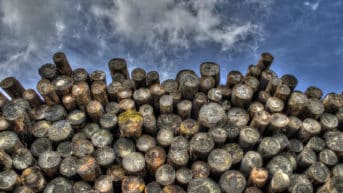Are you looking to make big capital gains with forestry stocks such as West Fraser Timber (TSX:WFT)?
If so, you should read this article before making a decision.
Here’s the normalized five-year price chart of West Fraser Timber compared to the Canadian market. You can easily tell that the forest product stock is above-average volatile. So, the adage of buying low and selling high is of utmost importance when it comes to investing in this forestry stock.
WFT data by YCharts. Price chart comparison between TSX:WFT and TSX:XIU.
Let’s explore the idea.
West Fraser Timber is a leading diversified wood products company in North America. As of writing, its market cap is about $4.4 billion. It has maintained or increased its dividend per share since 2011.
Explaining the super strong growth in the past few years
West Fraser Timber performed strongly in the past few years. From 2016-2018, its adjusted earnings per share increased at a compound annual growth rate of more than 80%! Last year, earnings per share “only” increased by 50%.
Investors should note that the strong growth had partly to do with acquisitions and share buybacks. In the past few years, West Fraser Timber spent about 21% of its cash flow in acquisitions ($602 million), about 43% on capital spending ($1.2 billion), and about 38% on stock buybacks and dividends ($1 billion).

The operating cash flow shows a more normalized picture. West Fraser Timber’s operating cash flow remained stable in 2018 compared to 2017. On a per-share basis, however, operating cash flow increased by about 12.5% thanks to a huge share count reduction of 10%.
At about $65 per share as of writing, the company trades at about 5.6 times 2018 operating cash flow. However, it’s not very meaningful to compare its current valuation to its historical multiples because of the acquisitions.
Net debt to capital was 17% at the end of 2018, which looks reasonable. The stock is given an investment-grade S&P credit rating of “BBB-”.
Investor takeaway
Going forward, West Fraser Timber’s growth relies more or less on lumber prices. If it can find fitting acquisitions with a price that makes sense for where we’re at in the economic cycle, it can boost growth, too.
Investors should note that the company competes with global producers, of which some could have greater competitive advantages in terms of having lower production costs or greater financial resources. That said, West Fraser Timber is a big player in North America and should have some competitive advantages over its smaller peers.
West Fraser Timber is in a cyclical business that relies on commodity pricing. Therefore, it’s going to be tough for investors to invest in West Fraser Timber.
However, when they feel the stock has bottomed, adventurous investors may choose to bet a small amount in the stock for a potential wild ride to the upside. Currently, it’s impossible to tell whether the stock is basing. Cautious investors should first wait to see if the stock will break below the support at about $60.
Currently, Thomson Reuters has a 12-month mean target of $80.50 per share on West Fraser Timber, which represents near-term upside potential of nearly 24%.
Stay hungry. Stay Foolish.
 Stock Up Sale
Stock Up Sale








